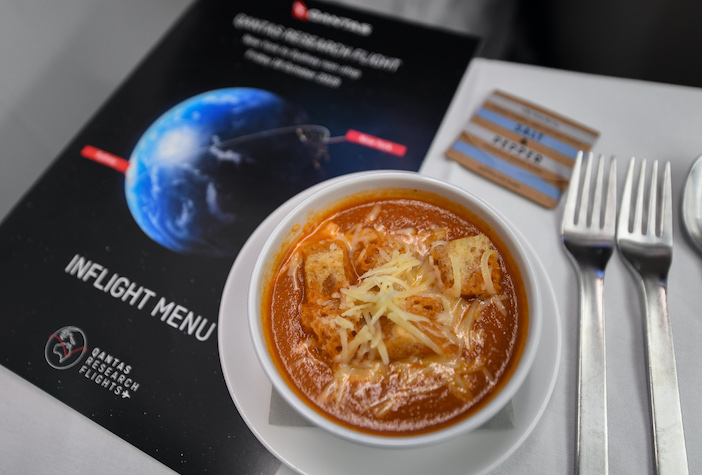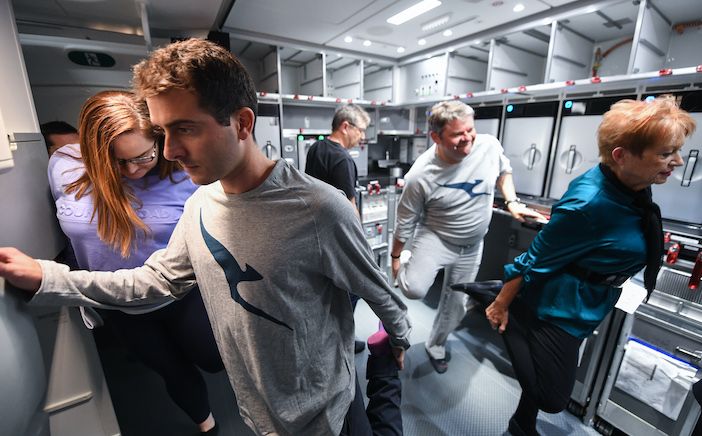Australian airline Qantas and the University of Sydney’s Charles Perkins Centre have been collaborating on a research project that is looking into how the inflight travel experience can be altered to reduce the effects of jetlag.
The research, which the partners say is a world-first project, was conducted during test flights for Qantas’ Project Sunrise programme, which will see its A350-1000s connect Sydney directly with New York and London for the first time from late 2025.
A key figure in the research is Peter Cistulli, Professor of Sleep Medicine at the University of Sydney. “We have a multi-disciplinary team of more than 10 researchers from medicine, science and engineering backgrounds working together on this project. This includes sleep researchers, circadian experts, nutrition and movement experts. No airline has ever done this kind of research before,” he said. “The early findings have given us optimism that we can make a real difference to the health and wellbeing of international travellers thanks to this partnership with Qantas.”
Several factors have been investigated by the team, including cabin lighting, sleep and meal schedules, and the use of specific ingredients such as chilli and chocolate, which the project has found can contribute to improved traveller wellbeing. An important but unsurprising factor that benefits inflight wellbeing is movement and exercise – especially given that Project Sunrise involves non-stop flights of up to 22 hours.
A little background on the research
The airline has been working with the University of Sydney’s Charles Perkins Centre since 2015 when it first began preparations to launch direct flights from Perth, Australia to London, UK.
In 2019 Qantas then operated three Project Sunrise research flights from New York and London to Sydney in 2019 in partnership with Australian researchers to collect real-world passenger data. Researchers travelling on the aircraft monitored 23 volunteer customers during the 20-hour flights, who followed a specially designed sequence of menu, lighting, sleep and movement. The volunteers were fitted with wearable device technology to track movement, sleep and light exposure.

The volunteers also tried special food and beverage menus and service timings designed to encourage their body clocks to adjust to the destination time zone. Specific times were allocated for out of seat movement and activities, which included tests completed on iPads, similar to a game of ‘Whack a Mole’, which gauged reaction times and attention span.
The initial findings, which are as yet unpublished, indicate that, compared to customers on a traditional inflight sequence of eating and sleeping, those on the tailored schedule experienced less severe jet lag (self-reported), better sleep quality inflight. The passengers kept a daily log for a week prior to the flight, during the flight, and for two weeks after the flight, and noted how they felt throughout the study. It was found that they reported better cognitive performance in the two days after flight than without the measures.
The inflight trials of jetlag-preventing ideas involved tailored cabin lighting schedules to facilitate adaption to the destination time zone and integrating simple stretch and movement activities. The researchers also adjusted the timing of meal services to align the body clock and encouraged wake and sleep by using specific menu items including fish and chicken paired with fast-acting carbohydrates, as well as comfort foods like soups and milk-based desserts. The aim was to promote the brain’s production of the amino acid tryptophan (‘Tryp’) to help passengers get to sleep more easily.
Room to manoeuvre
Movement and exercise has been addressed in the Airbus A350s that Qantas will use for Project Sunrise flights, mainly through the onboard Wellbeing Zone, in which premium economy and economy passengers can take time out from their seats to stretch and do simple exercises onboard, guided by instructions on video screens.
Such a space is unusual in aircraft cabins, in which every square inch of space is the most expensive real estate in the world. However, if the 22-hour Project Sunrise flights were too uncomfortable then customers could instead opt for the usual stopover flights, despite the time penalty of around three hours. Thus the airline is fitting around 100 fewer seats in its A350s than most of its competitors, which opens up space to create more legroom in all cabin classes as well as the Wellbeing Zone, located between the premium economy and economy cabins.

Professor Peter Cistulli from University of Sydney said while the research is still ongoing, there are clear signs that the interventions implemented during the trial flights reduce the health impact of ultra-long-haul travel.
“The early results are promising, and have given us great momentum to look to the next stage of customer research to support Project Sunrise product and service design,” said Professor Cistulli.
Qantas Group CEO Alan Joyce said the national carrier was excited by the prospect of minimising jetlag for every travel class.
“Given our geography, Qantas has a long history of using imagination and innovation to overcome the tyranny of distance between Australia and the rest of the world,” said Joyce. “Now that we have the aircraft technology to do these flights, we want to make sure the customer experience evolves as well, and that’s why we’re doing this research and designing our cabins and service differently.
“People can choose how they spend their time but we’ll make recommendations based on science around menu choices and best times to eat or rest. That extends to before and after the flight, to improve how people feel when they arrive on the other side of the world.”

What’s next?
The Charles Perkins Centre and Qantas will take part in a first-ever combined lighting workshop at Airbus’ Hamburg headquarters later this year where specialists will design the cabin lighting settings for the aircraft, including reviewing the optimal brightness and colour tone settings for each phase of the flight.
Parallel research has been carried out to manage crew wellbeing on these flights, which also draws on experience from other ultra-long-haul flights operated by Qantas.
Qantas is scheduled to take delivery of its first A350 in late 2025, with the Project Sunrise launch route between Sydney and New York expected to take off shortly after.






